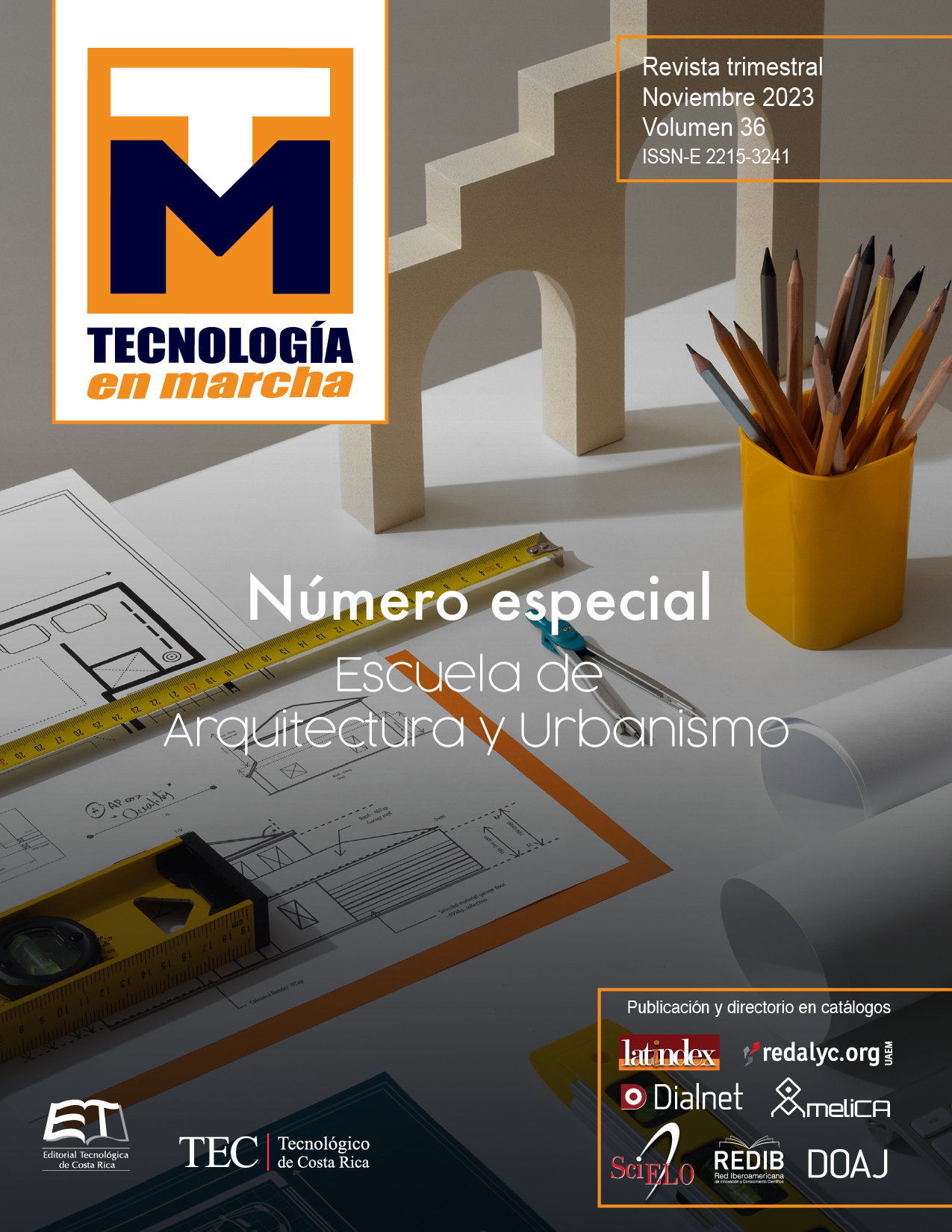Digital twinship in heritage buildings and the evolution of this concept in scientific production
Main Article Content
Abstract
The aims of this paper are to describe what is meant by “digital twin of patrimonial works” and to present the results of a bibliometric analysis of scientific publications dealing with this concept. These articles were registered in the Elsevier Scopus database, during the period between 2018 and July 2022. This analysis was developed by the research team, from the Costa Rican Technological Institute, of the project: “Digital twin as a management tool of the programmed conservation plan; case study: foyer and smokers of the National Theater of Costa Rica”. This scientific production was carried out prior to the formal start of the execution of the project, to generate a precise contextualization of the topic in question and as input for the development of its objectives.
The bibliometric indexes described include authors, time of publication, affiliations, countries with the highest scientific production related to the concept and main research niches. A total of 35 publications were considered, produced by 151 authors, from 66 affiliations, in 21 countries. It was determined that, although the conceptualization of the digital twin of heritage works exists within the scientific production, there are few cases and, therefore, of the development of the tool.
Article Details

This work is licensed under a Creative Commons Attribution-NonCommercial-NoDerivatives 4.0 International License.
Los autores conservan los derechos de autor y ceden a la revista el derecho de la primera publicación y pueda editarlo, reproducirlo, distribuirlo, exhibirlo y comunicarlo en el país y en el extranjero mediante medios impresos y electrónicos. Asimismo, asumen el compromiso sobre cualquier litigio o reclamación relacionada con derechos de propiedad intelectual, exonerando de responsabilidad a la Editorial Tecnológica de Costa Rica. Además, se establece que los autores pueden realizar otros acuerdos contractuales independientes y adicionales para la distribución no exclusiva de la versión del artículo publicado en esta revista (p. ej., incluirlo en un repositorio institucional o publicarlo en un libro) siempre que indiquen claramente que el trabajo se publicó por primera vez en esta revista.
References
P.A. Jouan & P. Hallot, “Digital Twin: A HBIM-based methodology to support preventive conservation of historic assets through heritage significance awareness”. International Archives of the Photogrammetry, Remote Sensing and spatial Information Sciences, 42, pp. 609-615, 2019. doi: https://doi.org/10.5194/isprs-archives-XLII-2-W15-609-2019. [Online] Available: https://www.int-arch-photogramm-remote-sens-spatial-inf-sci.net/XLII-2-W15/609/2019/
M. Grieves & J. Vickers, “Digital twin: Mitigating unpredictable, undesirable emergent behavior in complex systems”, Transdisciplinary perspectives on complex systems, Springer, Cham, pp. 85-113, 2017. doi: https://doi.org/10.1007/978-3-319-38756-7_4. [Online]. Available: https://link.springer.com/chapter/10.1007/978-3-319-38756-7_4
E. Dezen-Kempter, D.L. Mezencio, E.D.M. Miranda, D.P. De Sá, & U. Dias, “Towards a Digital Twin for Heritage Interpretation-from HBIM to AR visualization”, Anthropocene, Design in the Age of Humans - Proceedings of the 25th CAADRIA Conference - Volume 2, Chulalongkorn University, Bangkok, Thailand, pp. 183-191, 5-6 August 2020. doi: https://doi.org/10.52842/conf.caadria.2020.2.183. [Online]. Available: http://papers.cumincad.org/cgi-bin/works/paper/caadria2020_141
J.P. Bulgarelli-Bolaños, R.E. Malavassi-Aguilar, I. Hernández-Salazar, E. Salazar-Ceciliano, & M. Carranza-Solano, “Diagnóstico de las fases de ejecución, cierre y conservación programada en los proyectos de intervención de bienes inmuebles patrimoniales en Costa Rica”, Instituto Tecnológico de Costa Rica, San José, Costa Rica, 2021. Revisado: agosto 15, 2022. [En línea]. Accesible: https://repositoriotec.tec.ac.cr/handle/2238/13322
M. Aria & C. Cuccurullo, “Bibliometrix: An R-tool for comprehensive science mapping analysis”, Journal of informetrics, 11(4), 959-975. 2017. doi: http://dx.doi.org/10.1016/j.joi.2017.08.007. [Online]. Available: https://www.sciencedirect.com/science/article/abs/pii/S1751157717300500?via%3Dihub
D. Torres-Salinas (2020). Bibliometrix: Primeros pasos y técnicas avanzadas con BiblioShiny App [Documento PDF]. Accesible: 10.5281/zenodo.4327614, 2020
J. E. Hirsch, “An index to quantify an individual’s scientific research output”, Proceedings of the National academy of Sciences, vol. 102, n.o 46, pp. 16569-16572, 2005. doi: https://doi.org/10.1073/pnas.0507655102. [Online]. Available: https://www.pnas.org/doi/abs/10.1073/pnas.0507655102

